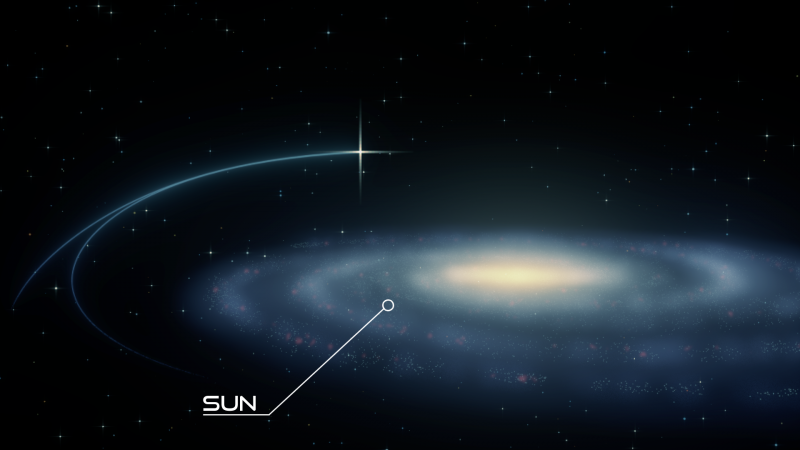New hypervelocity binary star challenges dark matter, stellar acceleration models

A team of astronomers at the Friedrich Alexander University led by Péter Németh has discovered a binary star moving nearly at the escape velocity of our galaxy. There are about two dozen so-called hypervelocity stars known to be escaping the galaxy. While all of them are single stars, PB3877 is the first wide binary star found to travel at such a high speed. Additionally, the results of the new study challenge the commonly accepted scenario that hypervelocity stars are accelerated by the supermassive black hole at the galactic center. The findings are being published in the Astrophysical Journal Letters today.
The team, in collaboration with researchers from the California Institute of Technology, showed the binary cannot originate from the Galactic Center, and no other mechanism is known that is able to accelerate a wide binary to such a high velocity without disrupting it. They therefore hypothesized there must be a lot of dark matter to keep the star bound to the Milky Way galaxy; or the binary star, PB3877, could be an intruder that has been born in another galaxy and may or may not leave the Milky Way again.
PB3877 was first reported to be a hyper-velocity, hot compact star, when it was discovered form the Sloan Digital Sky-Survey (SDSS) data in 2011. New spectroscopic observations were done with the 10 meter Keck II telescope at W. M. Keck Observatory on Maunakea, Hawaii and with the 8.2 meter Very Large Telescope (VLT) of the European Southern Observatory (ESO) in Chile.Caltech astronomers Thomas Kupfer and Felix Fürst observed PB3877 with the ESI Instrument fitted on the Keck II telescope.
"When we looked at the new data, much to our surprise, we found weak absorption lines that could not come from the hot star," Kupfer said. "The cool companion, just like the hot primary, shows a high radial velocity. Hence, the two stars form a binary system, which is the first hyper-velocity wide binary candidate."
The surface of the hot compact star is more than five times hotter than the Sun, while the companion is a thousand degrees cooler than our Sun. The system was determined to be 18,000 light years away. The mass of the hot compact star is only half of the mass of our Sun, and the companion is .7 times the mass of the Sun.
"We studied hyper-velocity stars since 2005, the year of discovery of the first three," said team-member Ulrich Heber. "In the meantime about two dozen have been found, but all are single, none has a companion directly visible in its spectrum."
The center of our galaxy hosts a supermassive black hole that can accelerate and eject stars from the galaxy by disrupting an original binary star. Hence, most hyper-velocity stars are believed to originate from the galactic center.
"From our calculations we can exclude the Galactic Center as the place of origin, because its trajectory never came close to it," said team member Eva Ziegerer, specialist in stellar kinematics who collected the astrometry data and reconstructed the orbit of the binary. "Other ejection mechanisms, such as stellar collisions and a supernova explosion have been proposed, but all of them would lead to the disruption of a wide binary."
"PB3877 may be an intruder from another galaxy," Németh said. "In that case its prolonged gradual acceleration would not harm its integrity. The outskirts of our Galaxy contain various stellar streams that are believed to be the remnants of dwarf galaxies that were torn to shreds by the strong tidal force of the Milky Way."
Unfortunately, the available data do not allow to make a connection to any of the known streams. Therefore, the origin of the binary remains unclear and so is its future. Whether or not the system remains bound to the Galaxy depends on the amount of dark matter in the Galaxy. Therefore, the mere existence of this binary puts pressure on our models and on our current understanding of dark matter in the Milky Way.
"We used different mass models to calculate the probability that the star will actually remain bound to the Galaxy. Only for the most massive Galaxy model this is the case. This makes PB3877 an excellent target to probe dark matter halo models," said Andreas Irrgang, research associate at the Dr. Karl Remeis-Observatory.
The research continues with high-resolution spectroscopy to confirm the orbital properties of PB3877 and with a photometric follow-up to search for variability. "By finding further stars or binaries on similar orbits would indicate an external origin. Therefore, our quest for similar strangers will continue," Németh said.
The W. M. Keck Observatory operates the largest, most scientifically productive telescopes on Earth. The two, 10-meter optical/infrared telescopes near the summit of Maunakea on the Island of Hawaii feature a suite of advanced instruments including imagers, multi-object spectrographs, high-resolution spectrographs, integral-field spectrographs and world-leading laser guide star adaptive optics systems.
ESI (Echellette Spectrograph and Imager) is a medium-resolution visible-light spectrograph that records spectra from 0.39 to 1.1 microns in each exposure. Built at UCO/Lick Observatory by a team led by Prof. Joe Miller, ESI also has a low-resolution mode and can image in a 2 x 8 arc-min field of view. An upgrade provided an integral field unit that can provide spectra everywhere across a small, 5.7 x 4.0 arc-sec field. Astronomers have found a number of uses for ESI, from observing the cosmological effects of weak gravitational lensing to searching for the most metal-poor stars in our galaxy.
More information: Péter Németh et al. AN EXTREMELY FAST HALO HOT SUBDWARF STAR IN A WIDE BINARY SYSTEM, The Astrophysical Journal (2016). DOI: 10.3847/2041-8205/821/1/L13
Journal information: Astrophysical Journal , Astrophysical Journal Letters
Provided by W. M. Keck Observatory





















